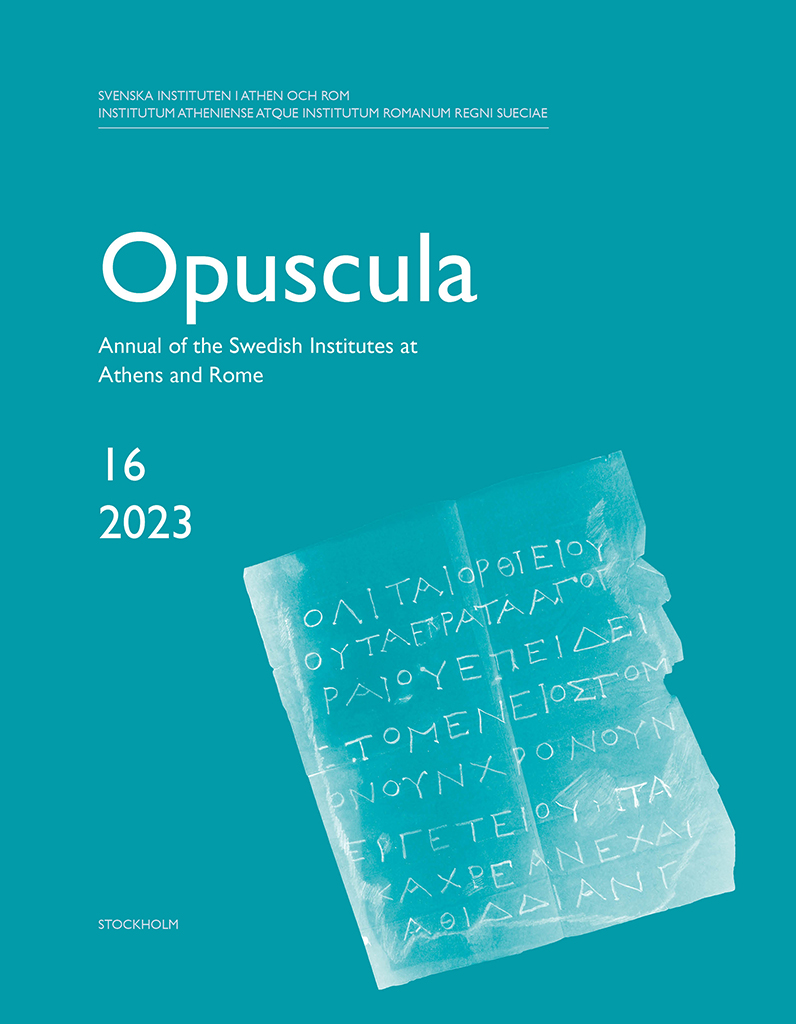Opuscula 16 is published by the Swedish Institutes at Athens and Rome. Distributed by Eddy.se AB. View volume at ERIH PLUS. All content available with open access. An overlooked 2nd-century BC decree by the polis of the Orthieians, Thessaly By Robin Rönnlund Abstract The National Archive of Monuments in Athens contains a dossier with documents regarding complications relating to road construction works in 1905 at the then-unknown archaeological site of Kedros in Western Thessaly. Among the documents is a paper copy of a fragmentary inscription of the 2nd century BC, reportedly found at the site. The preserved text of the inscription indicates that it was an honorific decree set up by the polis of the Orthieians to a benefactor from the nearby city of Gomphoi. Bibliographical information Robin Rönnlund, ‘An overlooked 2nd-century BC decree by the polis of the Orthieians, Thessaly’, Opuscula. Annual of the Swedish Institutes at Athens and Rome (OpAthRom) 16, Stockholm 2023, 113-131. ISSN: 2000-0898. ISBN: 978-91-977799-5-1. Softcover, 268 pages. https://doi.org/10.30549/opathrom-16-05
Opuscula 15 is published by the Swedish Institutes at Athens and Rome. Distributed by Eddy.se AB. View volume at ERIH PLUS. Roman and Early Byzantine evidence from the area of Palamas. A preliminary report of the ongoing Greek-Swedish archaeological work in the region of Karditsa, Thessaly By Maria Vaïopoulou, Robin Rönnlund, Fotini Tsiouka, Johan Klange, Derek Pitman, Sotiria Dandou, Rich Potter, Lawrence Shaw, Lewis Webb, Stelios Ieremias, Ian Randall & Harry Manley Abstract This paper presents preliminary results of the Palamas Archaeological Project relating to the Late Roman and Early Byzantine periods in the study area in western Thessaly, Greece. These periods are comparatively understudied in Thessaly, and the aim of this work is to highlight the extent of the material and the potential of investigating the archaeology of Late Antiquity in the region. The work was centred on excavations and survey at the site at Vlochos, alongside architectural survey at the neighbouring site on Kourtikiano hill. The paper also presents studies into Late Roman and Early Byzantine material found during cleaning at Vlochos. Additionally, an unpublished inscription spoliated in a church in nearby Palamas is presented. The results show a dynamic and detailed range of Late Antique activity in…
Opuscula 7 (2014) is now available for purchase and free download at Bokorder.se. Also available at Amazon.com, Amazon.de, Bokus.com and Adlibris.com. Karpophoroi deities and the Attic cult of Ge. Notes on IG II2 4758 By Jenny Wallensten Abstract Karpophoros, fruit-bearing, is an epithet easily considered as “literary”, i.e., a poetic name with little or no relation to cult. The epigraphic sources, however, clearly show us that gods thus named were offered divine worship. The epithet is found in connection with several deities. Goddesses of agriculture, such as Demeter, and Ge, the Earth, naturally carry this name, but so do Zeus, Dionysos and a goddess known as “The Aiolian”, who was sometimes associated with Agrippina. This paper surveys deities known as karpophoroi and examines what their cult entailed. Its focus is, however, on a brief Acropolis inscription, IG II2 4758, where Ge is honoured as Karpophoros, in accordance with an oracle. The case study provides insights into the Attic cult of Ge, the epithet Karpophoros, as well as the use and function of epithets within Greek dedicatory language. Bibliographical information Jenny Wallensten, ‘Karpophoroi deities and the Attic cult of Ge. Notes on IG II2 4758’, Opuscula. Annual of the Swedish Institutes…
Distributed by Astrom Editions. View at WorldCat. A survey of Greek and Latin inscriptions on stone in Swedish collections Edited by Bengt E. Thomasson in collaboration with Monica Pavese. A presentation, with text and short commentary, of 202 Greek and Latin inscriptions on stone kept in collections in Göteborg (the Department of Classics and Röhsska Konstslöjdsmuseet), Uppsala (the Collection of Classical Antiquities), Stockholm (the Museum of Mediterranean and Near Eastern Antquities, the National Museum, the Gustav III:s antikmuseum, Millesgården and a private collection) and Umeå (the University of Umeå), as well as Rome (Istituto Svedese) and Anacapri (Villa San Michele di Axel Munthe). Contents Preface (p. 7) Introduction (pp. 9–10) Bibliographical abbreviations (p. 11) Inscriptions at the Swedish Institute in Rome (p. 13) La collezione epigrafica di Villa San Michele di Monica Pavese (pp. 15–75) The collection in Göteborg (pp. 77–83) The collection in Uppsala (pp. 84–94) The collection in Stockholm (pp. 95–120) Indices (pp. 121–127) Concordantiae (pp. 128–129) Bibliographical information Bengt E. Thomasson (ed.), A survey of Greek and Latin inscriptions on stone in Swedish collections (Skrifter utgivna av Svenska Institutet i Rom, 8°, 22), Stockholm 1997. ISSN: 0283-8389. ISBN: 91-7042-154-4. Softcover: 129 pages. Reviews Arctos 31, 1997, 235-238…




